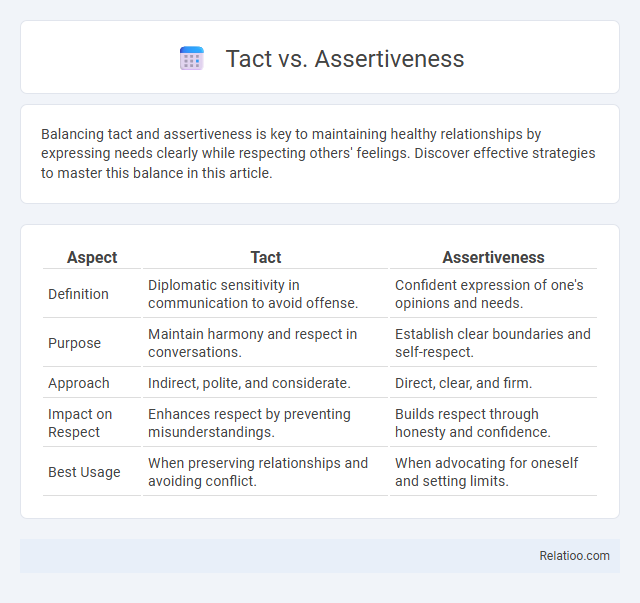Balancing tact and assertiveness is key to maintaining healthy relationships by expressing needs clearly while respecting others' feelings. Discover effective strategies to master this balance in this article.
Table of Comparison
| Aspect | Tact | Assertiveness |
|---|---|---|
| Definition | Diplomatic sensitivity in communication to avoid offense. | Confident expression of one's opinions and needs. |
| Purpose | Maintain harmony and respect in conversations. | Establish clear boundaries and self-respect. |
| Approach | Indirect, polite, and considerate. | Direct, clear, and firm. |
| Impact on Respect | Enhances respect by preventing misunderstandings. | Builds respect through honesty and confidence. |
| Best Usage | When preserving relationships and avoiding conflict. | When advocating for oneself and setting limits. |
Understanding Tact and Assertiveness
Understanding tact involves recognizing social cues and communicating with sensitivity to others' feelings, ensuring messages are conveyed diplomatically. Assertiveness centers on confidently expressing one's needs, rights, and opinions without aggression, maintaining respect for both self and others. Balancing tact and assertiveness allows for clear, respectful communication that fosters cooperation and minimizes conflict.
Key Differences Between Tact and Assertiveness
Tact involves delivering messages sensitively to avoid offending others, emphasizing empathy and social awareness, while assertiveness focuses on confidently expressing one's own needs and boundaries without aggression. Key differences include tact's priority on preserving relationships through diplomacy versus assertiveness's goal of standing firm on personal rights and opinions. Understanding when to apply tact or assertiveness enhances effective communication and conflict resolution in both personal and professional settings.
The Importance of Tact in Communication
Tact plays a crucial role in communication by allowing individuals to express their thoughts and opinions sensitively to avoid offending others, thus fostering positive relationships. While assertiveness emphasizes standing up for oneself confidently and directly, tact ensures that this confidence is delivered with consideration and respect, promoting constructive dialogue. Effective communicators balance tact and assertiveness to achieve clarity while maintaining empathy and professionalism.
The Role of Assertiveness in Personal Success
Assertiveness plays a crucial role in personal success by enabling individuals to express their thoughts and needs confidently without infringing on others' rights. While tact involves polite communication to maintain harmony and avoid conflict, assertiveness balances honesty and respect to advocate effectively for oneself. Mastering assertiveness improves decision-making, fosters better relationships, and enhances leadership capabilities crucial for achieving personal and professional goals.
Common Misconceptions About Tact and Assertiveness
Common misconceptions about tact and assertiveness often confuse politeness with passivity, leading people to underestimate the power of clear, respectful communication. Many believe tact means avoiding conflict at all costs, while assertiveness is mistaken for aggression, ignoring that both rely on empathy and self-confidence. Understanding that tact involves delivering messages considerately and assertiveness requires expressing needs firmly without disrespect helps clarify their distinct yet complementary roles in effective interpersonal interactions.
Situations That Require More Tact
Situations that require more tact often involve sensitive topics, such as delivering constructive criticism, navigating workplace conflicts, or addressing cultural differences. Employing tact in these moments ensures communication remains respectful and empathetic, minimizing misunderstandings and emotional reactions. Unlike assertiveness, which emphasizes clear and direct expression of needs, tact prioritizes consideration of the other person's feelings to maintain positive relationships.
When to Use Assertiveness Over Tact
Choose assertiveness over tact when you need to clearly communicate boundaries or express important needs without ambiguity, especially in high-stakes or urgent situations. Assertiveness is effective for addressing conflicts directly and ensuring your voice is heard while maintaining respect. Your ability to discern when to shift from subtle diplomacy to firm communication can significantly impact personal and professional outcomes.
Blending Tact and Assertiveness Effectively
Blending tact and assertiveness effectively requires balancing clear, confident communication with sensitivity to others' feelings and perspectives. Practicing assertiveness while maintaining tact helps in expressing needs and boundaries without causing offense or conflict. Mastering this balance enhances interpersonal relationships and fosters productive, respectful dialogue in both personal and professional settings.
Benefits of Balancing Tact and Assertiveness
Balancing tact and assertiveness enhances your communication by allowing you to express your needs confidently while respecting others' feelings, leading to stronger relationships and reduced conflicts. Tact ensures that your message is delivered with sensitivity, preventing misunderstandings, whereas assertiveness empowers you to stand up for yourself without aggression. Mastering this balance improves workplace collaboration and personal interactions, fostering trust and effective problem-solving.
Practical Tips for Developing Tact and Assertiveness
Developing tact involves practicing empathy, active listening, and choosing words that convey respect and understanding, especially in sensitive situations. Assertiveness requires setting clear boundaries, expressing your thoughts confidently without aggression, and using "I" statements to communicate needs effectively. Balancing tact and assertiveness enhances interpersonal relationships by ensuring honesty while maintaining consideration for others' feelings.

Infographic: Tact vs Assertiveness
 relatioo.com
relatioo.com